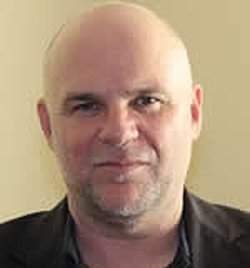Anthony Pym (born 1956, Perth, Australia) is a scholar best known for his work in translation studies. Pym is currently Professor of Translation and Intercultural Studies at Rovira i Virgili University in Spain.He is also President of the European Society for Translation Studies, a fellow of the Catalan Institution for Research and Advanced Studies, Visiting Researcher at the Monterey Institute of International Studies, and Professor Extraordinary at Stellenbosch University.
Pym was one of the first to move the study of translation away from texts and towards translators as people. He has also conceptualized translating as a form of risk management, rather than a striving for equivalence. He has hypothesized that translators can be members of professional intercultures, operating in the overlaps of cultures, and that their highest ethical goal is the promotion of long-term cross-cultural cooperation. In recent years he has been attracted to the concept of inculturation, through which he sees translation as one of the ways in which minority cultures are absorbed into wider cultural systems and can then modify those wider systems.
Pym's ideas have been contrasted with those of the American translation theorist Lawrence Venuti by the Finnish translation scholar Kaisa Koskinen, and his critique of Venuti has been commented on by Jeremy Munday and Mary Snell-Hornby.
Schleiermacher and the problem of Blendlinge
Schleiermacher’s two opposed methods suppress a hidden middle term, the living translator, and the whole of Schleiermacher’s text is designed to silence that middle term. In fact, entire line of binary translation theories, ending with most recent found in Lawrence Venuti attempts to silence middle terms.
Pym does not find much of originality in the thought of Schleiermacher as the idea of moving the reader towards author was already present by Goethe first and Herder later but before Schleiermacher. Schleiermacher’s movement was more nationalist in nature, and it became more stronger by Napoleonic invasion of Germany in June 1813 a few days ahead of Schleiermacher ’s lecture.
Schleiermacher makes no reference to any actual translation, therefore, his text is chain of metaphors, and empty. Schleiermacher simply manipulates metaphors to say something about translation, and text can be seen as manipulating translation as a metaphor of belonging.
Schleiermacher idea of literal translation for rendering a sense of foreignness to be considered as highest and most difficult task comes close to most easiest and most foolish. Translators risk going too far, betraying themselves and their language. They risk upsetting what Lefevere lables, the most delicate balance (p156) strangely translating what Schleiermacher calls ‘die feinste Linie’, the fines of lines (p56). Schleiermacher will be upset, in any case ‘because everyone strikes that balance’.
On the matter of Blendlinge, Pym defines that this is a positive word even in the German context, therefore, he strongly criticizes Schleiermacher for reinforcing cultural nationalism and considers Blendlinge as substantial people, as the intercultural communities to which translators could belong. In doing, translation studies might promote mediation rather than separation. Translation history could help give such communities a substantial past; translation ethics should help develop their regime; and the training of the translators could openly contribute to their ranks. Hence importance of human Blendlinge in translation studies.
Like Dryden, Schleiermacher refers to unnatural movements, to the translator as a sideshow performer. He similarly recognizes these as the dangers of literalism, and yet since Schleiermacher supports the literalism that Dryden opposes, he ironizes these negative values in two ways. First he mixes in bizarre isotopic complex based on the family (mother tongue, unnatural children, children abandoned to acrobats). Second, he proposes to shock the reader as much as is necessary to keep him aware of what he is doing (ie readers know that they are reading translation, announcing what amounts to translating alienation effect.
While trying to demand too much from the translator to fully implement the reader- to- author method, Schleiermacher forgets to recognize identify of the translator who is the main mediator between two cultures and remains between the reader and the writer. In the words of Anthony Pym, “In historical terms, the exclusion suppresses most of the intercultural people that have produced great translators. It gets rid of Zwischenstaaten that have long mediated-and translated – between France and Germany, and are too easily forgotten as the gristle of the European Union. It also suppresses virtually all the conceptual tools I use to think about translation”.
Notes: Binary Translation: Pertinent to linguistic theories is Newmark’s binary classification of translation into semantic and communicative, which somehow resembles Nida’s formal and dynamic equivalence. “Communicative translation,” Newmark (1981:39) states, “attempts to produce on its readers an effect as close as possible to that obtained on the original. Semantic translation attempts to render, as closely as the semantic and syntactic structures of the second language allow, the exact contextual meaning of the original. figure (Newmark,1981: 39): ST BIAS – LITERAL- FAITHFUL- SEMANTIC against TT BIAS – FREE- IDIOMATIC- COMMUNICATIVE






